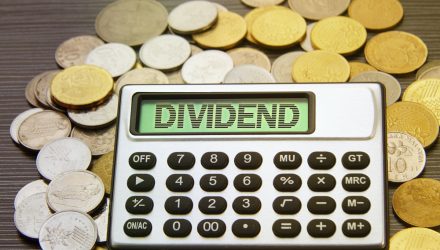The S&P 500 is home to plenty of negative dividend action this year, but that once ominous outlook is improving, potentially spotlighting opportunity with the FlexShares Quality Dividend Defensive Index Fund (NYSEArca: QDEF) along the way.
QDEF offers dividend growth potential and security due to FlexShares’ proprietary dividend quality scoring methodology.
The Dividend Quality Score process is designed to maximize quality and yield while putting several diversification controls into effect through its selection and weighting process. FlexShares’ multi-faceted dividend quality score examines companies based on three factors when determining their dividend quality indexing methodology.
“S&P 500 companies are likely to see an aggregate 2% decline in 2020 dividend payments, compared with analyst projections earlier this year of around 10%, according to S&P Dow Jones,” reports Reuters. “That’s good news for income-seeking investors at a time when a series of rapid interest rate cuts by the Federal Reserve has taken U.S. Treasury yields to near zero, sending market participants further afield in search of steady payouts.”
QDEF’s Quality Matters
FlexShares’ quality dividend indexing methodology targets management efficiency or quantitative evaluation of a firm’s deployment of capital and its financing decisions. By using a management efficiency screen, the index can screen out firms that aggressively pursue capital expenditures and additional financing, which typically lose flexibility in both advantageous and challenging partitions of the market cycle.
“S&P 500 companies slashed or suspended over $40 billion in dividends in the second quarter, the deepest quarterly drop since 2009, according to S&P Dow Jones. The cuts tapered off in the latter part of the quarter as the U.S. economy began to rebound, fueled by Fed stimulus and easing lockdowns across the nation,” according to Reuters.
QDEF’s emphasis on cash flow provides a better understanding of liquidity levels for a company. A firm that does not meet its debt obligations and day-to-day liquidity needs are likely to be poorly positioned to take advantage of future opportunities or have a financial cushion during downturns.
“The gap between the S&P 500 dividend yield and the 10-year Treasury US10YT=RR yield in March hit a high not seen since at least the 1970s, according to Datastream data, which does not go back further. Currently, the S&P 500’s dividend is nearly 2%, compared with the benchmark 10-year U.S. Treasury’s 0.67% yield,” according to Reuters.
Conversely, QDEF yields a far more impressive 2.76%.
For more on multi-asset strategies, please visit our Multi-Asset Channel.
The opinions and forecasts expressed herein are solely those of Tom Lydon, and may not actually come to pass. Information on this site should not be used or construed as an offer to sell, a solicitation of an offer to buy, or a recommendation for any product.

